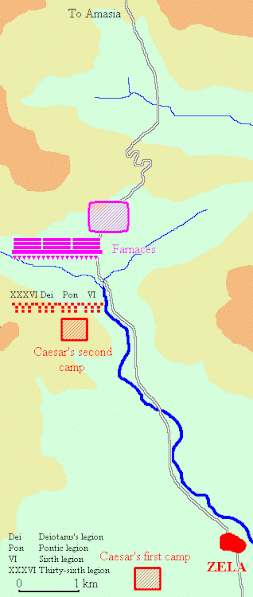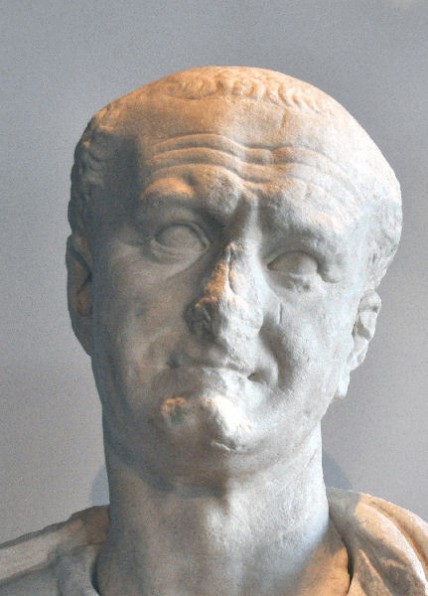Legio XXII Deiotariana
Legio XXII Deiotariana: one of the Roman legions. The name is derived from Deiotarus, a king who was allied with the Romans.

Deiotarus (c.105-40) was the leader of the Tolistobogii, a Celtic tribe living in what is now central Turkey. He was a loyal ally of Rome during the wars against Mithridates VI Eupator of Pontus. In 63/62, the Roman commander Pompey made him king of all Celts in Turkey, which are usually called Galatians. With the help of Roman advisers, he built a large army, which consisted, in 48 BCE, of 12,000 infantry and 2,000 cavalry. The Roman author Cicero suggests that they were divided into thirty cohorts, which is the equivalent of three legions.
After a defeat against king Pharnaces II of Pontus, the survivors were regrouped into one legion, which was among the troops of Julius Caesar during the battle of Zela (2 August 47).
When Galatia was annexed by the emperor Augustus (25 BCE), these troops were integrated by governor Marcus Lollius in the Roman army. The unit was from now on called legion XXII Deiotariana. The number was chosen because the Augustean legions numbered to twenty-one (XXI Rapax), so the addition had to be twenty-two.
It was transferred to Alexandria in Egypt, where it stayed for more than a century. When this happened is not clear, but the first Egyptian evidence dates back to the year 8 BCE. Our unit shared its base near Alexandria with III Cyrenaica. Sometimes, these legions were used to suppress violence among the ethnic groups living in the city (Greeks, Egyptians, and Jews). A description of one outburst of ethnic violence can be found here.
No senator was allowed to visit Egypt without the emperor's permission. The province was extremely important for the Roman food supply and a senator might be tempted to cut off the grain trade, starve the city, and proclaim himself emperor. Therefore, XXII Deiotariana was not commanded by a senator, but by a prefect from the equestrian order.
It is likely that (subunits of) XXII Deiotariana took part in the Roman attack on Arabia Felix (Yemen) in 26-25 BCE. This campaign, commanded by the prefect-governor of Egypt, Aelius Gallus, was very difficult. Even worse, during the absence of the Roman garrison, the Nubian kingdom of Meroe attacked Upper Egypt. In 24, the Romans retaliated. Commanded by Gaius Petronius, the legions marched upstream along the Nile and reached Napata, the ancient northern capital of Nubia. Although their presence is not attested, soldiers of XXII Deiotariana must have taken part in this campaign. After this, the frontier between Nubia and the Roman empire became more quiet.

Soldiers were employed at several places in Egypt. For example, they erected an (unidentified) building in Akfahas, south of Memphis. They were also working in the quarries of Mons Claudianus, where grey granite was won. Other legionaries were sent to the far south, where they left their signatures on the Colossi of Memnon.
In 63, a subunit took part in the Parthian expedition of Domitius Corbulo, and another subunit fought in the Jewish War of 66-70. The Jewish historian Flavius Josephus praises the courage of the soldiers of the Alexandrine legion. During the civil war of 69, XXII Deiotariana and III Cyrenaica sided with the pretender Vespasian, who became emperor.
The legion is attested for the last time in 119 (or perhaps 123), when it was still in Alexandria with III Cyrenaica, and was no longer in existence during the reign of Marcus Aurelius, when a catalogue of legions was made (CIL 06.3492). The unit was probably destroyed by the Jews during the revolt of Simon ben Kosiba (132-136).
Its legionary symbol is not known. Maybe, a Gallatian (=Celtic) emblem was used.
Literature
- S. Daris, "Legio XXII Deiotariana", in: Yann Le Bohec, Les légions de Rome sous le Haut-Empire (2000 Lyon) 365-367
- J. Kramer, "Die Wiener Liste von Soldaten der III. und XXII. Legion (P. Vindob. L2)" in: Zeitschrift für Papyrologie und Epigraphik 97 (1993) 147-158